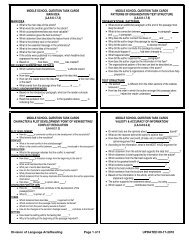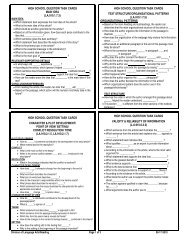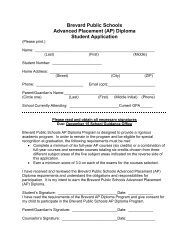Science Research Program Guide - Secondary Programs Home ...
Science Research Program Guide - Secondary Programs Home ...
Science Research Program Guide - Secondary Programs Home ...
You also want an ePaper? Increase the reach of your titles
YUMPU automatically turns print PDFs into web optimized ePapers that Google loves.
<strong>Research</strong> Plan<br />
REQUIRED for ALL Projects Before Experimentation<br />
A complete research plan must accompany Checklist for Student (1A)<br />
Provide a typed research plan and attach to Student Checklist (1A).<br />
The research plan for ALL projects is to include the following:<br />
A. Question being addressed<br />
B. Hypothesis/Problem/Engineering Goals<br />
C. Description in detail of method or procedures (The following are important and key items that should be included when formulating<br />
ANY AND ALL research plans.)<br />
• Procedures: Detail all procedures and experimental design to be used for data collection<br />
• Data Analysis: Describe the procedures you will use to analyze the data that answer research question or hypothesis<br />
D. Bibliography: List at least five (5) major references (e.g. science journal articles, books, internet sites) from your literature<br />
review. If you plan to use vertebrate animals, one of these references must be an animal care reference.<br />
o Choose one style and use it consistently to reference the literature used in the research plan<br />
o <strong>Guide</strong>lines can be found in the Student Handbook.<br />
These are guidelines and should be followed where applicable. *Refer to Items 1-4 below.<br />
1. Human subjects research (See instructions on p. 13 of the International Rules):<br />
• Detail all procedures, include what the participants are asked to do (see p. 13)<br />
• Describe Risk Assessment process and how risks will be minimized<br />
o Include strategies used to protect privacy and confidentiality<br />
• Describe Study Sample/Human Subjects<br />
o Number of human subjects and estimated demographics (may include information such as: age, male/female, cultural<br />
background breakdown, socio-economic status)<br />
o Recruitment procedures (where and how subjects are recruited)<br />
o Procedures for obtaining informed consent must include statement about informing potential human subjects about voluntary<br />
nature of participation and right to withdraw at any time<br />
• Include survey or questionnaires if used, and critically evaluate the risk<br />
o List and describe the measures (questionnaires, surveys) used and how you measure the variable of interest (behavioral<br />
observations, time, length). Attach the questionnaire/survey<br />
o Consider emotional stress and potential consequences<br />
• Describe any physical activities or procedures, if used, and critically evaluate the risks<br />
o Type, duration of exercise or physical activity<br />
o Ingestion method, amount, intervals, etc.<br />
2. Vertebrate animal research (See instructions on p.17 of the International Rules):<br />
• Briefly discuss POTENTIAL ALTERNATIVES and present a detailed justification for use of vertebrate animals<br />
• Explain potential impact or contribution this research may have<br />
• Detail all procedures to be used<br />
o Include methods used to minimize potential discomfort, distress, pain and injury to the animals during the course of<br />
experimentation<br />
o Detailed chemical concentrations and drug dosages<br />
• Detail animal numbers, species, strain, sex, age, etc.<br />
o Include justification of the numbers planned for the research<br />
• Describe housing and oversight of daily care<br />
• Discuss disposition of the animals at the termination of the study<br />
3. Potentially Hazardous Biological Agents (See instructions on p.21 of the International Rules):<br />
• Describe Biosafety Level Assessment process and resultant BSL determination<br />
• Give source of agent, source of specific cell line, etc.<br />
• Detail safety precautions<br />
• Discuss methods of disposal<br />
4. Hazardous Chemicals, Activities & Devices (See instructions on p.25 of the International Rules):<br />
• Describe Risk Assessment process and results<br />
• Detail chemical concentrations and drug dosages<br />
• Describe safety precautions and procedures to minimize risk<br />
• Discuss methods of disposal<br />
International Rules 2008/2009 full text of the rules and copies of forms are available at www.societyforscience.org/isef Page 31

















